PRICE INDEXES AND CONTRACT PRICE INDEXATION
SEPTEMBER QUARTER KEY FIGURES
 | Jun Qtr 06 to Sep Qtr 06 | Sep Qtr 05 to Sep Qtr 06 |
| STAGE OF PRODUCTION | % change | % change |
|
| Final (Stage 3) commodities (excl. exports) | 1.0 | 4.0 |
| Domestic | 1.3 | 4.8 |
| Imports | -1.1 | 0.0 |
| Intermediate (Stage 2) commodities | 1.3 | 6.7 |
| Domestic | 1.4 | 6.5 |
| Imports | 1.1 | 8.5 |
| Preliminary (Stage 1) commodities | 1.7 | 7.7 |
| Domestic | 1.7 | 7.2 |
| Imports | 2.1 | 11.0 |
|
Final Stage, Base: 1998-99 = 100.0
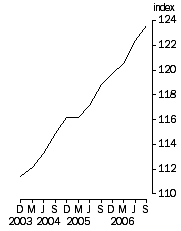
| Final Stage, Quarterly % change

|
SEPTEMBER QUARTER KEY POINTS
FINAL (STAGE 3) COMMODITIES
- The final (Stage 3) index rose 1.0% in the September quarter 2006.
- The domestic component rose 1.3%, mainly due to increases in building construction, other agriculture, electricity, gas and water and real estate agents. These increases were partially offset by decreases in petroleum refining and meat products.
- The imports component fell by 1.1%, due to price decreases for beverage and malt, electronic equipment and industrial machinery. These decreases were partially offset by increases in tobacco, clothing, knitting mills and other transport.
INTERMEDIATE (STAGE 2) COMMODITIES
- The intermediate (Stage 2) index rose 1.3% in the September quarter 2006.
- The domestic component rose 1.4%, mainly due to increases in electronic equipment, property operators and developers, legal and accounting services, other business services and metal ore mining. These increases were partially offset by decreases in petroleum refining and other agriculture.
- The imports component rose 1.1%, due to increases in oil and gas extraction, basic chemicals, iron and steel, and fabricated metal products. These increases were partially offset by decreases in electronic equipment and beverages and malt.
PRELIMINARY (STAGE 1) COMMODITIES
- The preliminary (Stage 1) index rose 1.7% in the September quarter 2006.
- The domestic component rose 1.7% mainly due to property operators and developers, metal ore mining, legal and accounting services and electrical equipment. These increases were partially offset by decreases in petroleum refining and other agriculture.
- The imports component rose 2.1%, due to oil and gas extraction, basic chemicals, iron and steel and basic non-ferrous metals. These increases were partially offset by decreases in electronic equipment and petroleum refining.
NOTES
FORTHCOMING ISSUES
| ISSUE (QUARTER) | Release Date |
| December 2006 | 22 January 2007 |
| March 2007 | 23 April 2007 |
CHANGES IN THIS ISSUE
There are no changes in this issue.
RELATED STATISTICS
For more information about statistics in this publication contact Lee Taylor on Canberra (02) 6252 6251, or email <lee.taylor@abs.gov.au>.
INQUIRIES
For further information about these and related statistics, contact the National Information and Referral Service on 1300 135 070 or Lee Taylor on Canberra (02) 6252 6251.
COMMENTARY
STAGE OF PRODUCTION OVERVIEW
Each of the three stages of the production indexes increased in the September quarter 2006, with the preliminary (Stage 1) index showing the largest rise of 1.7%, followed by an increase of 1.3% for the intermediate (Stage 2) index, and an increase of 1.0% for the final (Stage 3) index. Through the year to September quarter 2006, the preliminary (Stage 1) index increased by 7.7%, followed by an increase of 6.7% for the intermediate (Stage 2) index and an increase of 4.0% for the final (Stage 3) index.
The increase of 1.0% in the final (Stage 3) index reflects an increase of 1.3% in the price of domestically produced items, offset by a fall of 1.1% in the price of imported items. The domestic component increased due to price rises for building construction, other agriculture, electricity, gas and water, and real estate agents. These were partially offset by decreases in petroleum refining and meat products. The imports component decreased due to price falls for beverage and malt, electronic equipment and industrial machinery, which were partially offset by increases in tobacco, clothing, knitting mills and other transport.
The increase of 1.3% in the intermediate (Stage 2) index reflects an increase of 1.4% in the price of domestically produced items and an increase of 1.1% in the price of imported items. The domestic component increased due to price rises for electronic equipment, property operators and developers, legal and accounting services, other business services and metal ore mining. These were partially offset by price decreases for petroleum refining and other agriculture. The imports component increased due to price rises for oil and gas extraction, basic chemicals, iron and steel and fabricated metal products, which were partially offset by price falls for electronic equipment, and beverages and malt.
The increase of 1.7% in the preliminary (Stage 1) index reflects an increase of 1.7% in the price of domestically produced items and an increase of 2.1% in the price of imported items. The domestic component increased due to price rises for property operators and developers, metal ore mining, legal and accounting services and electrical equipment, which were partially offset by price decreases for petroleum refining and other agriculture. The imports component increased due to price rises for oil and gas extraction, basic chemicals, iron and steel and basic non-ferrous metals, which were partially offset by price falls for electronic equipment and petroleum refining.
COMPARISION OF SOP INDEXES: Base: 1998-99 = 100.0

MANUFACTURING INDUSTRIES PRODUCER PRICE INDEXES
During the September quarter 2006, the prices paid by manufacturers for their material inputs increased by 0.8%, while the prices they received for their outputs increased by 0.3%. The input price index increased by 10.1% through the year to September quarter 2006 and the output price index for the same period increased by 7.9%.
Increases in the price of imported crude oil, iron ore, sheep and lambs, and nickel ores and concentrates were the main contributors to the quarterly result for the materials used in manufacturing industries index. Price decreases for domestic crude, whole milk, gold and poultry provided some offset to these increases.
Higher prices received for nickel, nickel mattes, other metals and copper wire contributed to the bulk of the increase in the articles produced by manufacturing industries index for the September quarter 2006. These increases were partially offset by decreases in the prices received for unleaded petrol, diesel and aluminium smelting.
ARTICLES PRODUCED BY MANUFACTURING INDUSTRIES, All groups: Quarterly % change
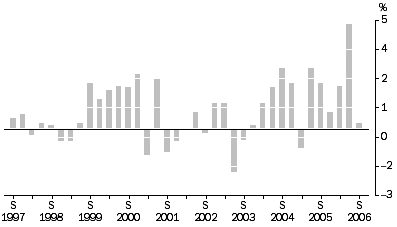 MATERIALS USED IN MANUFACTURING INDUSTRIES, All groups: Quarterly % change
MATERIALS USED IN MANUFACTURING INDUSTRIES, All groups: Quarterly % change

CONSTRUCTION INDUSTRIES PRODUCER PRICE INDEXES
The price indexes for materials used in house building increased by 1.5% in the September quarter 2006, following a 1.0% increase in the June quarter 2006. The most significant contributors to the increase were copper pipework, mains cable and conduit, and joinery. Offsetting price decreases were recorded for insulation and timber doors. Increases were recorded in all of the state capitals, ranging from 0.4% in Brisbane to 2.3% in Perth.
Through the year to September quarter 2006, the materials used in the house building index rose 3.3%.
Materials Used in House Building, All groups: Quarterly % change
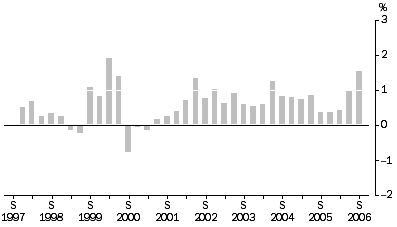
The price index for the output of the general construction industry increased by 1.1% in the September quarter 2006 and by 4.3% through the year to September quarter 2006. Increases were registered in the quarter for all component industries, with non-residential building construction being the largest contributor, followed by residential building construction other than houses, road and bridge construction, and house construction.
Contributing to the movement of general construction industry price indexes across the country this quarter were increases in material costs and, to a lesser extent, labour costs. As in the previous quarter, items and services utilising copper experienced significant rate rises and therefore had a significant impact on the indexes for building construction (other than houses). Shortages in skilled labour are continuing to influence construction costs in some regions such as Queensland and Western Australia.
New South Wales provided the greatest contribution to the increase in the price index for the output of the general construction industry in the September quarter 2006, closely followed by Western Australia and Queensland. Victoria's contribution this quarter was negative, due mainly to a decrease in the price index for house construction in that state.
Output of the General Construction Industry, All groups: Quarterly % change
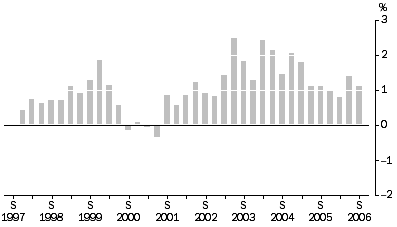
SERVICE INDUSTRIES PRODUCER PRICE INDEXES
The property & business services industries price index increased by 2.5% in the September quarter 2006 and by 5.6% through the year to September quarter 2006. The property services price index increased by 2.6% this quarter with increases for real estate agents and commercial property operators. Through the year to September quarter 2006 the property services index rose by 7.9%.
Property and Business Services Industries, All groups: Quarterly % change
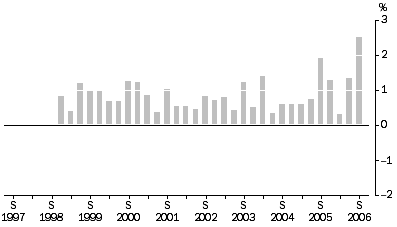
The business services index increased by 2.5% in the September quarter 2006 and by 4.1% through the year to September quarter 2006. The main contributors to the increase were legal services and consultant engineering services.
The transport (freight) and storage industries index increased by 1.1% in the September quarter 2006. The most significant contributors with price increases were road freight and rail freight transport. Contributors with price decreases were services to air transport and international sea transport. Through the year to September quarter 2006 the transport (freight) and storage industries index rose by 4.5%.
Transport (Freight) and Storage Industries, All groups: Quarterly % change
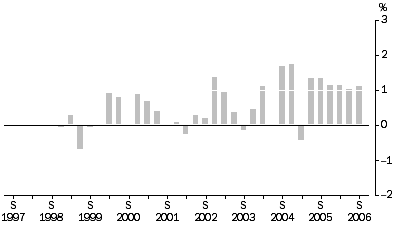
 Print Page
Print Page
 Print All
Print All